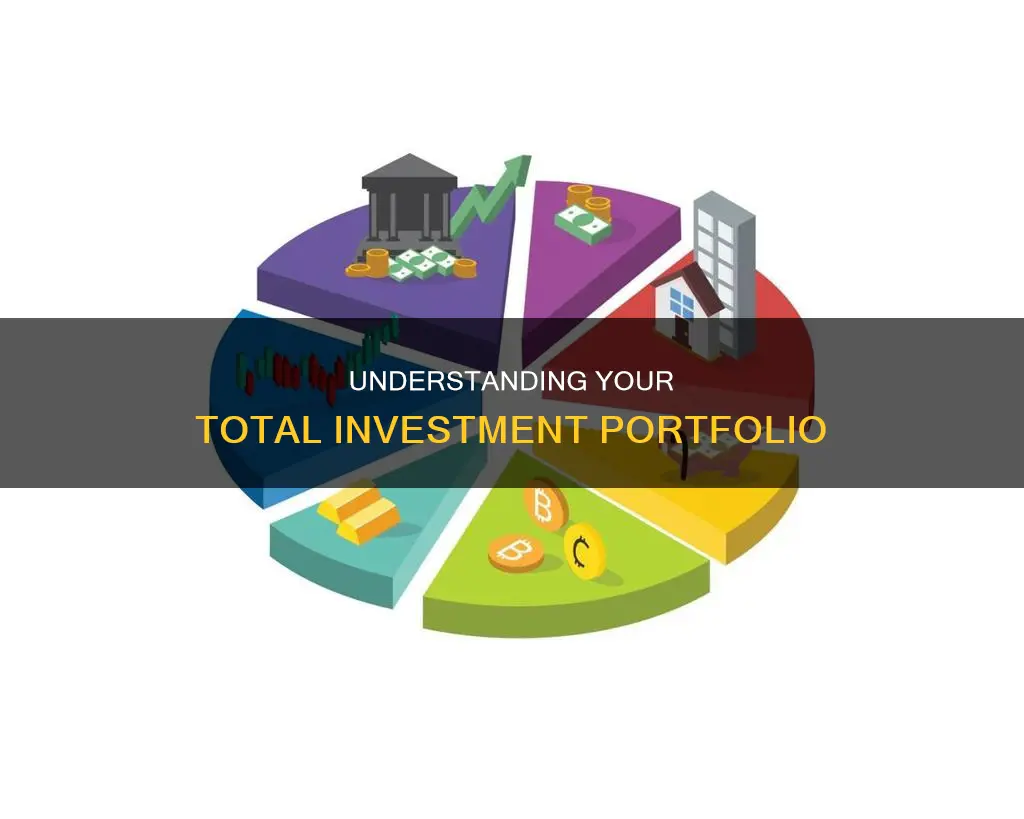
A total investment portfolio is a collection of financial assets and investment tools owned by an individual, financial institution, or investment firm. The assets in a portfolio can include stocks, bonds, cash, cash equivalents, currencies, commodities, and alternative investments such as gold, oil, and real estate. The objective of a portfolio is to generate revenue while preserving the original equity of the assets or capital. A well-diversified portfolio is essential to achieving financial goals while managing risk.
| Characteristics | Values |
|---|---|
| Definition | A collection of financial assets and investment tools |
| Owner | An individual, a financial institution or an investment firm |
| Components | Stocks, bonds, cash, cash equivalents, currencies, commodities, gold, oil, real estate, funds, derivatives, property |
| Objective | To generate revenue while preserving the original equity of the asset or capital |
| Management | Managed by the owner or a financial advisor |
| Diversification | A vital concept in portfolio management |
| Risk | Depends on the owner's risk appetite |
| Time Frame | Depends on the owner's financial goals |
What You'll Learn

Stocks
A total investment portfolio is a collection of financial investments, such as stocks, bonds, commodities, cash, and cash equivalents, including closed-end funds and exchange-traded funds (ETFs).
There are two primary types of stocks: common stock and preferred stock. Common stock is the most prevalent type, offering ownership and voting rights. Preferred stock, on the other hand, is a hybrid security with characteristics of both debt and equity. It usually pays fixed dividends and takes priority over common stockholders in liquidation.
The number of stocks to include in a portfolio depends on various factors, such as the country of residence, investment time horizon, market conditions, and the investor's propensity to stay updated on financial news. Diversification is critical to minimising risk and achieving long-term returns. While there is no magic number, it is generally recommended to have at least 10 stocks in a portfolio, with a mix of stocks from multiple sectors and a portion of fixed-income instruments to hedge against stock market downturns.
An aggressive portfolio, suitable for investors with a high-risk tolerance, would consist of underlying assets that take on greater risks in pursuit of greater returns. These investors seek out companies in their early growth stages, which are not yet well-known. In contrast, a defensive portfolio focuses on consumer staples that are resistant to economic downturns. Defensive stocks perform well regardless of economic conditions because they produce essential everyday products.
Additionally, an income-focused portfolio generates profits from dividend-paying stocks or other types of distributions to stakeholders. Real estate investment trusts (REITs) are examples of such income-producing investments.
Speculative portfolios are suitable for investors with a very high-risk tolerance. Speculative investments include initial public offerings (IPOs) or stocks rumoured to be takeover targets. Technology or healthcare firms developing a single breakthrough product also fall into this category.
It is important to note that the stock market is susceptible to various factors, including company performance, market conditions, and broader economic trends. Therefore, investors should carefully consider their risk tolerance, financial goals, and time horizon when constructing their stock portfolio.
Understanding Aaron's Portfolio: Equal Investment, Beta Calculation
You may want to see also

Bonds
A portfolio is a collection of financial investments, such as stocks, bonds, commodities, cash, and cash equivalents. While stocks, bonds, and cash are considered the core of a portfolio, it can also include real estate, art, and private investments.
- Income: Bonds are designed to provide income to the bondholder in return for lending money to the issuer.
- Diversification: Bonds, particularly government bonds, help diversify stock portfolios and reduce losses. They have a low correlation with other asset classes, which can help to reduce volatility in a portfolio.
- Relative Safety: Bonds generally have lower risks compared to stocks, especially for a diversified bond portfolio.
- Higher Returns than Bank Accounts: Bonds offer higher returns than traditional bank accounts while maintaining relatively low risk.
- Collateral: Bonds can be used as collateral for loans, including margin loans, to purchase other financial instruments.
Bond ETFs (exchange-traded funds) provide an easy way for investors to access the benefits of a bond portfolio. They can be purchased like stocks and offer instant access to ready-made bond portfolios. Aggregate bond ETFs provide access to a wide range of investment-grade bonds, while government bond ETFs are ideal for investors seeking to safeguard their stock holdings.
When constructing a bond portfolio, it is important to consider factors such as income taxation, total return, and the investor's risk tolerance. Properly constructed bond portfolios can be tailored to the investor's desired level of risk and return, providing income, total return, and diversification.
Savings, Investments, and Economics: Understanding the Equation
You may want to see also

Alternative investments
A total investment portfolio is a collection of financial investments, including stocks, bonds, commodities, cash, and cash equivalents. While stocks, bonds, and cash are often considered the core of a portfolio, it is not a rule set in stone. A portfolio can contain a wide range of assets, including real estate, art, and private investments.
Private Equity and Venture Capital
Private equity investments typically involve buying shares in a private company or a group of companies. Venture capital is a refined branch of stock investments, where investors put capital into private companies or start-ups instead of trading shares of public companies in an open market.
Hedge Funds
Hedge funds are investment funds that use complex and often speculative strategies to generate high returns. They are usually only available to accredited investors with a high net worth and substantial investment capital.
Real Estate
Real estate as an alternative investment includes investing in physical properties, property-based securities, real estate crowdfunding platforms, real estate investment trusts (REITs), and real estate mutual funds. Investors aim for capital appreciation of tangible assets and strive for operating income to provide ongoing, stable cash flow.
Commodities
Commodities are raw materials such as gold, silver, oil, or agricultural products. Investors can buy these tangible goods with real-world uses and often perpetual demand. For example, gold is considered a stable investment due to its use in various industries and its value as a store of value.
Art and Collectibles
Art, sports memorabilia, entertainment memorabilia, high-end watches, and other collectibles can be alternative investments. These items may gain historical worth or increase in value over time as related parties become more prominent.
Cryptocurrency
The emerging form of digital currency, cryptocurrency, is seen as an alternative investment as it falls outside the traditional scope of stocks and bonds. Cryptocurrency may provide capital appreciation or passive income through staking rewards.
Building a Million-Dollar Investment Portfolio: Strategies for Success
You may want to see also

Risk tolerance
An investor's risk tolerance is often shaped by factors such as age, investment goals, income, and future earning capacity. For example, younger investors with a higher risk tolerance may be comfortable investing their entire portfolio in stocks, as they have a longer time horizon to ride out market volatility. On the other hand, retirees or those approaching retirement age typically exhibit lower risk tolerance, preferring investments with guaranteed returns and low volatility.
Understanding one's risk tolerance is essential for effective portfolio construction. It helps investors determine their investment strategy, including the mix of stocks, bonds, and other assets. Those with aggressive risk tolerance tend to favour stocks, equity funds, and exchange-traded funds (ETFs), while conservative investors lean towards bonds, bond funds, and income funds. Moderate investors, on the other hand, strive for a balanced approach, diversifying their portfolios with a mix of stocks and bonds.
Additionally, risk tolerance assessments are available online through questionnaires and surveys, aiding investors in understanding their risk appetite and making informed investment decisions.
Investment-led Savings: The Economy's Driving Force
You may want to see also

Diversification
There are several ways to diversify a portfolio:
- Distributing investments across a wide range of vehicles, including cash, stocks, bonds, mutual funds, exchange-traded funds (ETFs), and other financial instruments.
- Maintaining diversity within each asset category. For example, including securities that vary by sector, industry, geographic region, and market capitalization for stocks, and varying maturities and credit qualities for bonds.
- Investing in securities with different risk profiles, allowing the possibility that significant gains in higher-risk areas may offset losses in more stable investments.
The primary goal of diversification is to limit the impact of volatility on a portfolio, helping to smooth out the ups and downs of investing. It is important to note that diversification does not guarantee a profit or protect against loss.
When diversifying, it is essential to consider one's risk tolerance, investment objectives, and time horizon. All portfolios should contain some degree of diversification, reflecting the investor's comfort with risk, return objectives, and constraints such as tax position and liquidity needs.
Crafting an Effective Investment Portfolio Presentation
You may want to see also
Frequently asked questions
A total investment portfolio is a collection of financial investments or assets owned by an individual, a financial institution, or an investment firm.
The components of a total investment portfolio are called asset classes. These include stocks, bonds, cash, cash equivalents, commodities, real estate, gold, and other alternative investments.
A total investment portfolio allows individuals to generate revenue while preserving their original capital. It is a way to diversify investments, manage risk, and maximise returns.







